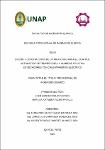Diseño y construcción de un prototipo para el control automático de temperatura y humedad relativa en secadores con calentamiento eléctrico

Date
2024Author
Bardales Vargas, Ever Luis
Rojas Padilla, Marlisa Katiuska
Metadata
Show full item recordAbstract
The general objective of the present thesis was: being designed for and constructing a prototype for the automatic control of temperature and relative humidity in driers with electric heating; for which, initially came true a designing proposal for the construction of said prototype, we determine in this way that his main components are: a PLC, a control of temperature, a relative humidity control, a cylindrical tunnel, an electrical resistance, a fan and an extractor. Straightaway, became elaborate the logic circuit making use of the software Zelio Soft2 V5.4.2, which allowed determining the quantity of inputs and physical outs that were used in the PLC, which worked out: four inputs (I1, I2, IB and IC) and three physical outs (Q1, Q2 and Q3); in the same ones that got connected the push-button I1, the push-button I2, the contact of the control of temperature, the contact of the control of relative humidity, the electrical resistance, the fan and the extractor, respectively. The results of performance testings suggested the following: a direct relationship between the entrance state is IB with the state of the physical exit Q1 of the PLC, there is a direct relationship between the entrance state IC with the state of the physical exit Q2 of the PLC; finally, an inverse relationship between the entrance state is IC with the state of the physical exit Q3 of the PLC. This way the present thesis was concluded, coming true with the realistic general and simultaneously trying on his general hypothesis. La actual tesis tuvo como objetivo general: diseñar y construir un prototipo para el control automático de temperatura y humedad relativa en secadores con calentamiento eléctrico; para lo cual, inicialmente se realizó una propuesta de diseño para la construcción de dicho prototipo, determinándose de esta forma que sus componentes principales son: un PLC, un controlador de temperatura, un controlador de humedad relativa, un túnel cilíndrico, una resistencia eléctrica, un ventilador y un extractor. Seguidamente, se elaboró el circuito lógico mediante el uso del software Zelio Soft2 V5.4.2, lo cual permitió estipular el número de entradas y salidas físicas que se emplearon en el PLC, las cuales son: cuatro entradas (I1, I2, IB y IC) y tres salidas físicas (Q1, Q2 y Q3); en las mismas que se conectaron el pulsador I1, el pulsador I2, el contacto del controlador de temperatura, el contacto del controlador de humedad relativa, la resistencia eléctrica, el ventilador y el extractor, respectivamente. Los resultados de las pruebas de funcionamiento indicaron lo siguiente: el estado de la entrada IB se relaciona directamente con el estado de Q1 del PLC, existe una relación directa entre el estado de IC con el estado de Q2 del PLC; por último, existe una relación inversa entre el estado de la entrada IC con el estado de la salida física Q3 del PLC. De este modo se concluyó la presente tesis, efectuándose el objetivo general y simultáneamente demostrándose la hipótesis general.
Collections
- Tesis [198]

